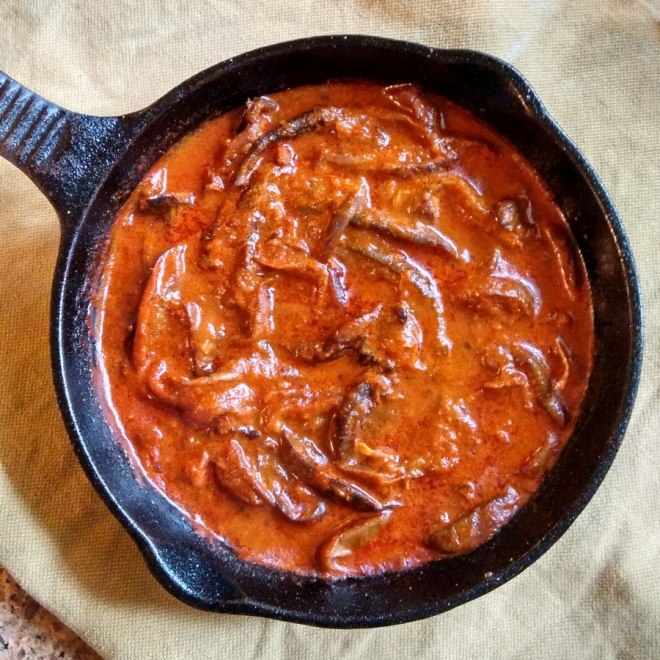
Drying is one of the oldest and easiest way to preserve food. In a country with plentiful sun it is only natural that we should have a tradition of using the sun’s energy to process food. You will find wadi varieties from all over the country. Bengalis put their bodi into many dishes including shukto, Southen India gives us vadams and appalams in addition to celebrating dried vegetables in, the most delicious of all ‘curries’, the vatahkuzhanmbu. In Uttarakhand mountain cucumbers are combined with urad-dal to make wadi. Punjab’s famous wadis which come in various flavours (with plums, with tomatoes, and regular – all spiced up with generous amounts of black pepper) can be combined with the blandest of vegetables to lift them out of the ordinary. From the state of UP we have mangodi, small wadis made with mung dal. Kashmiris make sun-dried spice-cakes and call them veri. Pickles that have been cooked in the sun for a while are found all over the country.
To use the season’s bounty and to tide over lean months or just for convenience it was also common to sun-dry vegetables. This has been almost lost in the times of frozen vegetables and out-of-season produce. Almost the only still-popular sun-dried vegetable in the North is kasoori methi. South Indians continue to use vathal, which could be made from many vegetables. The popular vathals that I have used and know of are sundakkai berries and cluster beans. These are used to cook vathakuzhambu an intensely tart ‘curry’ that is ambrosia to those of us who love rice.
The vegetables that I have myself dried include sundakkai berries, bittergourd (sliced), bird’s eye chilies, tomatoes (sliced), methi, and fragrant herbs such as mint (dried in shade!). I have also made majjiga mirapa, green chilies that have been soaked in salted yoghurt and then dried in the sun, which make an excellent side to South Indian meals. I make potato chips every years in early spring. Making papad is time consuming though I have tried my hand at sabudana and potato papads.
Kashmir, with its long and harsh winters, has a strong tradition of sun drying vegetables for use when the ground outside is covered with snow. The roads through the mountains were tough to traverse till not that long ago. My Dad remembers the time when the National Highway was a precarious single-carriage road, not something you could rely on for daily supplies. To get through the winter every household would put the autumn sun to good use. Vegetables such as eggplants, cauliflowers, gourds, tomatoes, potatoes, and turnips with their greens, would be strung into garlands and dried in the sun. Fruits were also dried though usually by the growers themselves. Dried fruits that are used in Kashmiri cooking include apples and quince, apricots, and sour cherries.
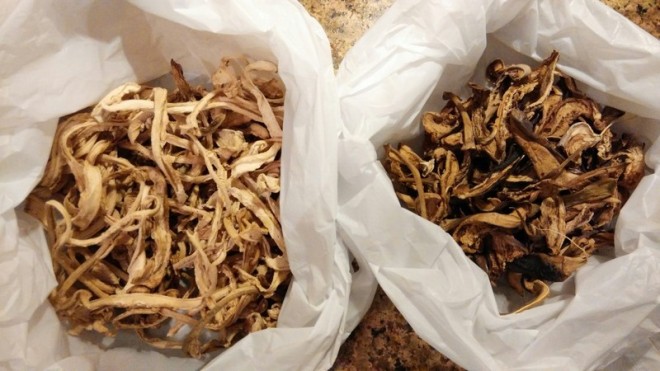
Dried vegetables are collectively called hokh syunu (hokh=dry and syunu=vegetable, or a preparation – stew- of vegetables or meat). Growing up in Delhi we had no need for dried vegetables. In fact, winter is the best season for produce around here. My mother had access to the best vegetables including what my Dad grew in his extensive vegetable-garden. He would grow monjji (kohl rabi), hakh, and sotchal, Kashmiri vegetables that were not to be found in the markets of Delhi up till the exodus of Kashmiri Pandits from the valley exactly 25 years ago. My parents married young (Dad was 21 and Mum 19!) and his job took them away from Srinagar. At that age my Mum had naturally not much kitchen experience and cooking hokh syunu is not exactly in the list of basics. Her later attempts, out of nostalgia, were not very successful and I only remember the unpleasant smells associated with cooking dried food whether turnips, cauliflower, or the seriously horrid-smelling ho-gaad, tiny dried fish that are a delicacy to some.
Mrs Sapru, Mum’s colleague at KVIIT, reintroduced her to hokk syunu but she never attempted cooking it herself again. Some years ago I got to taste tchoek-vangun, a popular dish of eggplant fried and cooked with tamarind, that had been prepared with vangun-hachi (sundried eggplant) instead of the fresh vegetable. I wanted to learn to cook it but Mum just shrugged and said she didn’t know how to. I would look longingly at the sacks of hokh syunu at Durga Masala Store and then move on. A month or so back I decided to finally just get me some. I talked to aunts and discussed on a Secret Kashmiri FB group that has quite a few seasoned Kashmiri homecooks as members.
The thing is that sun-drying does not just remove the moisture from a vegetable, it also alters the flavour. If not rehydrated correctly you may get an off-tasting, off-smelling dish. One evening I soaked half of the dried eggplant I had bought. I boiled the eggplant following Ms Langer Sher’s instructions closely. The rest of the steps were no different from what I normally do to cook a dish of tchok-wangun. The curry looked brown like most of ours do but the taste was good. That night it just went into the fridge because I already had too many leftovers to finish. I took it out the following day and my aunt would have been proud of what followed. I concluded it needed more oil, low-fat be damned. This looked nothing like the bright, delectable tchok-wangun that had me go on the hokh-syunu trail! I heated a little bit of mustard oil in the cast iron pan I had used earlier to fry maeshkreya, and proceeded to add to it a generous teaspoon of Kashmiri red chili powder. I then added my brown curry to the pan to reheat it. The critical bit of oil and chilies transformed my ugly ducking into the beautiful swan it really was all along!
Try this recipe with any dried vegetable see if you care for this sort of thing. I will be attempting cooking al-hachi soon!
Tchoek-vangun
Kashmiri Khatte Baingun – a tart curry with Eggplant
4 servings
50gm dried eggplant pieces*
a walnut-sized ball of tamarind, soaked in warm water for some time [walnuts, and not limes, are our measure-reference!]
2-4T mustard oil
2 t Kashmiri chilli powder
1 t sonth (ginger powder)
1 T saunf (fennel powder)
salt, to taste
a pinch of hing
Fill a pan with enough water to cover the eggplant pieces and bring to a boil. Boil gently for 10 minutes. Drain. Add cool water and rinse.Squeeze gently. Rinse and squeeze once more. Repeat if the rinsing water looks too dark. With this rinsing in hot and then cool water you have removed the bitterness and pungency of the vegetable.
Mash tamarind with your fingertips to remove the pulp. Discard the fibrous bits and any seeds.
Heat oil in a heavy pan. Add hing to the hot oil. Add the eggplant and fry on medium high stirring all the time, about 5 minutes. Add the spice powders and salt and give a good stir. Quickly, before the spices have a chance to burn, add the tamarind paste and a cup of water. Bring the water to boil. Cover the pan and simmer gently till done, about 10-15 minutes. Serve with steamed rice.
*If you are planning to make your own sun-dried eggplant, chose the small, slender ones, preferably the variety that is light-aubergine in colour! Slice them along the length into two and dry in the sun. You may also use the same variety fresh, slit the same way, to cook this dish.
As I shared the pictures of my success with vangun-hachi with cousins and aunts at a family gathering last week we all got talking about our less-known ingredients. A cousin makes maeshkreya at home and she is going to show me how to!
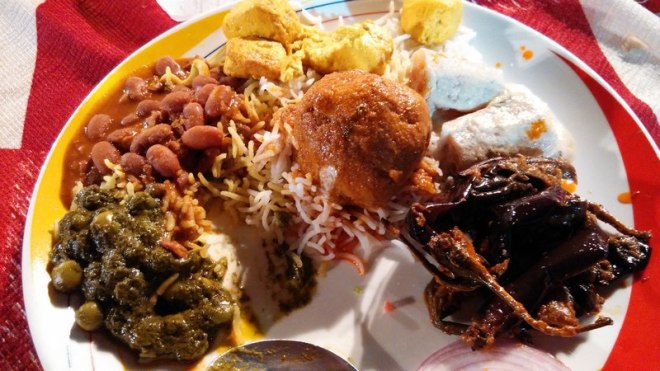
Tchoek-vangun prepared with fresh eggplant, on extreme right, at the mehndirat feast for a nephew’s thread-ceremony




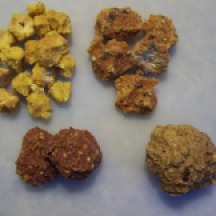





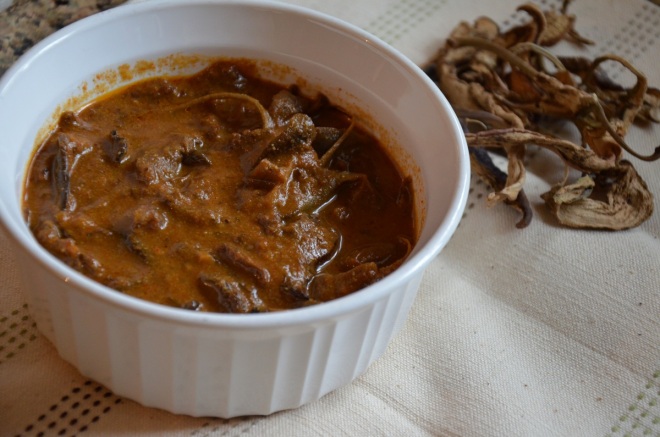
It’s interesting that tamarind is the souring agent of choice in this curry. I didn’t think it would be used much in Kashmiri cuisine.
It’s a good thing you specified walnut-sized cos lime without any qualifier is much bigger than the Indian nimbu.
And, just out of sheer curiosity, how long do these dried vegetables last?
You’re right, this is one of the few Kashmiri recipes that use tamarind. I think I know of only three: this, fish, and sour liver.
About the shelf-life of dried vegetables – why, are you still holding on to what you bought on your last visit?! 😉 If it is stored in a really dry place, such as where you are, it should last forever. I still have bitter-gourd I dried I-can’t-remember-when! But here, come monsoon, weevils usually get to all such food, including papads and wadis! Use it up quick or I’ll come and cook it for you, now that I know how to!
How interesting! I have a close Kashmiri friend and I love all the simple vegetarian dishes she prepares. Especially kohlrabi, a staple at her house and also the green apple ki sabzi. If you know, could you post a recipe for green apple sabzi? When I eat Kashmiri meals at her house, the flavors somehow evoke my South Indian spirits and I feel right at home, even though they taste different or have different ingredients. Happy cooking and eating! @greenmirchi
Nitya, try the quince and eggplant recipe on the blog. It is very likely your friend has a similar recipe with green apples!
You are right about Kashmiri and South Indian cuisines sharing a synergy – I claim to have been a Tamilian in my previous life! 😉
Very intrigued by all the dried vegetables you mention. I can relate to “smell horrid but taste wonderful” kind of food. You are talking about veggies and I know that is so true about fish. Anything dried has to be rehydrated optimally less and it does not cook well more and it will create a crumbled mess. In this dish the tamarind is a total surprise. The color is totally appetizing, I join you in saying goli maro to low fat. Enjoyed the post!
It is only now that I am beginning to cook these foods from Kashmir – strengthening the memories! Low-fat, show-fat.
love tsok wangun! I think I am obsessed with eggplant on general. I am curious about this secret FB group 🙂
I love it too! Have to try al-hacchi now.
The secret FB Group (Kaiggnaffri!) is just a silly group, more fun than serious, with some real morons thrown in, for extra fun.
The first photo reminded me of vathal kuzhambu! I also thought of ker sangri once I saw the rest of the photos – of the dried vegetables.
When you think about it, there are so many dried-foods that we all love! More common than you expect!
WHOA !! This looks ssensational. Mouthwateringly good !!
Have to try this out
It’s good! I hope you tried and it turned out well.
I would add my own flavour to this recipe. I have great memories of this dish and would count it as one of my favorites since childhood. Replace the tamarind with curd. Please understand that tamarind was not readily available in the Valley and most Kashmiries would not prefer tamarind because we thought it caused zukaam (nazlah).
I have always wondered at the use of tamarind in Kashmir. it didn’t grow locally that is why, perhaps, it was used only in a rare dish such as this or with fish. I will most certainly try with dahi and see how that changes the flavour.
This brinjal recipe is definitely genuine. Thanks for sticking to the authentic traditional recipe! 🙏